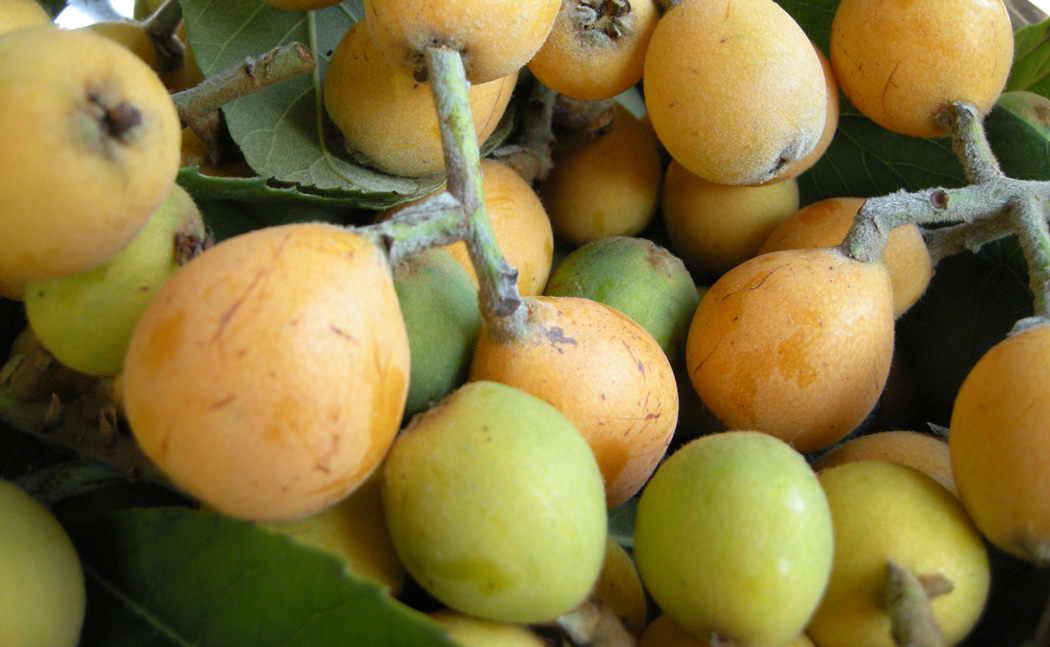The loquat, originally from China is a fruiting tree, often grown for ornamental purposes with large green leaves and small yellow or orange fruit. Loquat trees are generally drought tolerant and effectively grow in a wide range of climates thus contributing to their spread across the globe.
With the potential to grow to around ten metres tall, large loquat trees can be quite spectacular and add a tropical touch to the garden.
Fruit
Comparable in flavour to guava and passionfruit, the loquat tastes both sweet and sometimes acidic.
Loquats are usually yellow or orange, teardrop shaped and around 4cm long.
Loquat trees can produce fruit at the age of between 2 – 8 years depending on the tree’s health, cultivar and original propagation method (grafted plants fruit earlier).
As fragrant white flowers can be spotted on loquat trees as early as Autumn, fruit tends to be completely ripened around Spring. Ripe loquats tend to be orange in colour and are softer than unripened fruit.
Soil
Surprisingly, loquat trees can tolerate a wide range of soils from sandy to dense clay.
Provided that the soil is well drained and nutrient rich, loquats will thrive however they do prefer soils rich in organic matter with a slightly acidic PH balance.
If your soil is lacking in organic matter, a mixture of compost and cattle manure can be dug in to improve it. Loquat trees have a relatively shallow root system, therefore, preparing soil is only required at a shallow level.
Propagation
In most cases, loquats are propagated by seed.
The seeds can be removed from ripened fruit and immediately planted directly into soft potting soil. Once planted, the seeds can be watered from above daily to ensure that the soil is kept constantly moist. Soon enough your seeds will sprout and slowly begin growing.
The seedlings can be re-potted or planted into the ground once they have reached a height of around 15cm tall. Grafting has its advantages when it comes to loquats. When grafted, loquat trees can bear fruit at as early as 2 years of age. Rootstocks used for grafting loquat include those from quince trees and loquat seedlings.
Pests
Loquats can in some areas be affected by fruit fly, becoming a host to the pests during cooler months when other fruits are unavailable. Symptoms of fruit fly infestation include tiny holes in fruit and small maggots throughout the flesh. Removal of fruit fly can be difficult if not impossible, many local councils provide information on this matter. Other pests include aphids and a range of caterpillars which can both be easily controlled using products like dipel, derris dust and pyrethrum. Hand removal of these pests is also an option although this can be quite tedious.
Pruning
Immediately after harvesting, your loquat tree will be ready for pruning. Although pruning is not always necessary, loquats respond very well to pruning and will send out as many new branches as possible to replace those that you removed. These new branches will result in a larger harvest next year. Often, pruning is used to keep smaller loquat trees from getting larger making harvest easier.
Cutting away branches just above a node causes the tree to send out multiple branches in its place creating a heavier harvest the following year.
If branches need to be completely removed, cut the as close to their own base as possible. Alternatively, small shoots at the tips of each branch can be pinched out to halt further extension.
Fertiliser
Loquat trees flourish when given nitrogen based fertiliser three times a year, producing better fruit and more foliage. Chicken manure is an excellent organic source of nitrogen and can be moderately sprinkled around the topsoil of the tree and watered in well. Otherwise nitrogen based fertiliser can be purchased from your local nursery and applied by following the instructions on the label.
Loquats also respond well to complete fertiliser when it is applied once a year in peak growing season.
Water
As mentioned above, the loquat is drought tolerant.
Although loquats do not require very much water, it can certainly help them to grow faster and produce more fruit of a higher quality.
Deep watering every month or so in warmer months is needed as well as during cooler months if rain is lacking.
